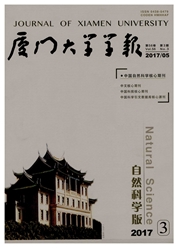

 中文摘要:
中文摘要:
从北极白令海深海沉积物中分离得到19株嗜冷细菌,通过测定16SrDNA序列对它们进行了分类鉴定及系统发育分析,并且与从热带西太平洋“暖池”区沉积物中分离的嗜冷细菌进行了比较.结果表明,由北极海底沉积物中分离得到的细菌主要属于γ-变形菌(γ-Proteobacteria),此外还有少量的铲变形菌和革兰氏阳性菌.在γ-变形菌中主要的菌属为假交替单胞菌属(Pseudoalteromonas),假单胞菌属(Pseudomonas)和希瓦氏菌属(Shewanellc).与西太平洋“暖池”区沉积物中的嗜冷细菌的比较分析表明,假交替单胞菌属和假单胞菌属在两个海域中普遍存在,而希瓦氏菌属的分布则表现出一定的地域性.系统发育分析表明,相同菌属但来自北极和西太平洋海域两个不同环境的嗜冷细菌在系统发育树中的位置都相对独立,有的还形成了独立的分支,说明其分子进化过程可能受到生存环境条件的影响.
 英文摘要:
英文摘要:
A total of 19 psychrophilic bacteria were isolated from deep sea sediment of Bering Sea, Arctic. The identification and phylogenetic analysis of these psychrophiles were carried out based on the comparison of 16S rDNA gene sequences. The phylogenetic relationship was compared among the psychrophiles isolated from deep sea sediment of Arctic and the tropical western Pacific "warm pool" area. The results showed that most of the arctic psychrophilic bacteria belonged to γ-proteobacteria, and the rest belonged to α- proteobacteria and gram-positive bacteria. The dominant genera of these bacteria were Pseudoalteromonas, Pseudomonas and Shewanella that belonged to γ-proteobacteria. Comparing with the psychrophilic bacteria isolated from the sediment of tropical western Pacific, Pseudoalteromonas and Pseudomonas were two universal genera in these two sea area, while the genus Shewanella only isolated from the Arctic Ocean. The phylogenetic analysis indicated that the psychrophilic bacteria isolated from sediment of Arctic and the western Pacific were located in the independent clade separately, some of them constitute an individual clade completely. These results possible suggested that the habitation and evolution of psychrophilic bacteria were affected by the environment.
 同期刊论文项目
同期刊论文项目
 同项目期刊论文
同项目期刊论文
 期刊信息
期刊信息
